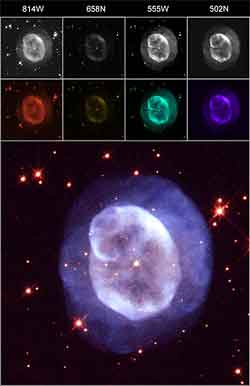FITS Format Liberation – DIY Astronomical Images With The Expert Touch

This previously unreleased colour image of the planetary nebula NGC 5979 was combined from raw FITS files with the ESA/ESO/NASA Photoshop FITS Liberator. In the top row the raw greyscale images are seen. Four individual exposures were combined to form this colour image and the colour filters for the individual exposures are indicated. The number refers to the colour;; or wavelength;; of light that the filter allows through. This is measured in nanometres (a millionth of a millimetre). The N’s and W’s in the filter name refer to whether the filter is a narrow-band (N) or a wide-band filter (W). The second row shows the individual exposures after a colorising layer has been applied in Photoshop. Image credit: ESA;; ESO and NASA
For many years astronomical images from the world’s telescopes were reserved for an elite of astronomers and technical people. Now anyone with a desktop computer running Adobe® Photoshop® software can try their hand at crafting astronomical images as beautiful as those from the Hubble Space Telescope. A free software plug-in, released today, makes a treasure trove of archival astronomical images and spectra from the NASA/ESA Hubble Space Telescope, the European Southern Observatory’s Very Large Telescope, the European Space Agency’s XMM-Newton X-ray observatory, NASA’s Spitzer Space Telescope and many other famous telescopes accessible to home astronomy enthusiasts.
If there is anything that unites astronomy, it is the worldwide use of a single file format – nearly all the images of stars and galaxies produced by telescopes on the ground and in space are stored as so-called FITS files. Unfortunately this file format has been accessible to very few people other than professional scientists using highly specialised image-processing tools.
Now a new and unique tool – the ESA/ESO/NASA Photoshop FITS Liberator – developed by imaging scientists at the European Space Agency, the European Southern Observatory and NASA makes the immense wealth of astronomical images and spectra stored in data archives around the world accessible to the layman. The only thing required is access to either Adobe Photoshop® or Adobe Photoshop Elements®, both leading image software packages.
For the professional creators of astronomical colour images, the plug-in revolutionises the workflow of the creation of colour images from raw data and gives a huge boost to the image quality by giving access to the full 16 bit (65536 colours) range of the observations. In addition the plug in may be used as a powerful educational tool when teaching about light, colour and digital images. Some examples of educational material are available at the web page below.
The ESA/ESO/NASA Photoshop FITS Liberator will be released today and is freely available for download from:
http://www.spacetelescope.org/projects/fits_liberator
Head of the development team, Lars Holm Nielsen from Denmark, says, “FITS is much more than just an image format. It is an extremely flexible file format that allows astronomers to share images and spectra in many different ways. This very versatility has made the job of producing a plug-in for Photoshop challenging. Compared to formats like JPEG, FITS files can be incredibly diverse.”
Media Contact
All latest news from the category: Physics and Astronomy
This area deals with the fundamental laws and building blocks of nature and how they interact, the properties and the behavior of matter, and research into space and time and their structures.
innovations-report provides in-depth reports and articles on subjects such as astrophysics, laser technologies, nuclear, quantum, particle and solid-state physics, nanotechnologies, planetary research and findings (Mars, Venus) and developments related to the Hubble Telescope.
Newest articles

Recovering phosphorus from sewage sludge ash
Chemical and heat treatment of sewage sludge can recover phosphorus in a process that could help address the problem of diminishing supplies of phosphorus ores. Valuable supplies of phosphorus could…

Efficient, sustainable and cost-effective hybrid energy storage system for modern power grids
EU project HyFlow: Over three years of research, the consortium of the EU project HyFlow has successfully developed a highly efficient, sustainable, and cost-effective hybrid energy storage system (HESS) that…

After 25 years, researchers uncover genetic cause of rare neurological disease
Some families call it a trial of faith. Others just call it a curse. The progressive neurological disease known as spinocerebellar ataxia 4 (SCA4) is a rare condition, but its…





















